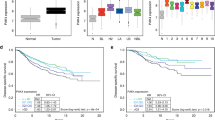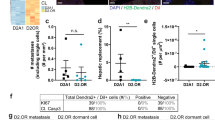Abstract
Aberrations affecting the tumor suppressor gene p16INK4a have been described for a variety of tumors. In breast cancer, approximately 50% of tumors show low or lack p16 expression. While evidence provided by some studies has implicated a possible role for p16 in normal replicative senescence, other studies have suggested that the Rb, pathway through which p16 functions, may not be involved in senescence control. Previously we observed that all immortal lines derived from normal mammary epithelium which were analysed for p16 displayed inactivation of this gene through distinct mechanisms, supporting p16 inactivation as a possible necessary event in escape from senescence. To further clarify this issue, we have analysed p16 expression in a panel of normal finite lifespan human mammary epithelial cells (HMEC) from initial propagation through growth arrest, using media which confer different replicative capacity. Approximately 10–25-fold increase in p16 expression was observed for all normal HMEC with initial onset of a senescence phenotype following 15–25 population doublings in culture. These cells also displayed expression of the senescence associated β-galactosidase. Interestingly, HMEC with additional long term replicative capacity (approximately 80 population doublings) arose from these growth arrested cultures, showing lack of p16 expression. This extended growth capacity appears to be associated with a methylation phenomenon since treatment of these cells with the methylation inhibitor 5-aza-2-deoxycytidine resulted in growth arrest concurrent with reacquisition of p16 expression and senescence associated β-galactosidase. Analysis of p21waf1 expression revealed no change in expression during growth in vitro. These results support p16INK4a as the 9p senescence gene and suggest a role for p16 loss in the escape from initial onset of senescence and in acquisition of an extended life span of human mammary epithelial cells.
This is a preview of subscription content, access via your institution
Access options
Subscribe to this journal
Receive 50 print issues and online access
$259.00 per year
only $5.18 per issue
Buy this article
- Purchase on Springer Link
- Instant access to full article PDF
Prices may be subject to local taxes which are calculated during checkout
Similar content being viewed by others
Author information
Authors and Affiliations
Rights and permissions
About this article
Cite this article
Brenner, A., Stampfer, M. & Aldaz, C. Increased p16 expression with first senescence arrest in human mammary epithelial cells and extended growth capacity with p16 inactivation. Oncogene 17, 199–205 (1998). https://doi.org/10.1038/sj.onc.1201919
Received:
Revised:
Accepted:
Published:
Issue Date:
DOI: https://doi.org/10.1038/sj.onc.1201919
Keywords
This article is cited by
-
A three-marker signature identifies senescence in human breast cancer exposed to neoadjuvant chemotherapy
Cancer Chemotherapy and Pharmacology (2023)
-
The transcriptome of wild-type and immortalized corneal epithelial cells
Scientific Data (2021)
-
Autofluorescence-based sorting removes senescent cells from mesenchymal stromal cell cultures
Scientific Reports (2020)
-
A prospect of cell immortalization combined with matrix microenvironmental optimization strategy for tissue engineering and regeneration
Cell & Bioscience (2019)
-
Autofluorescence is a Reliable in vitro Marker of Cellular Senescence in Human Mesenchymal Stromal Cells
Scientific Reports (2019)



